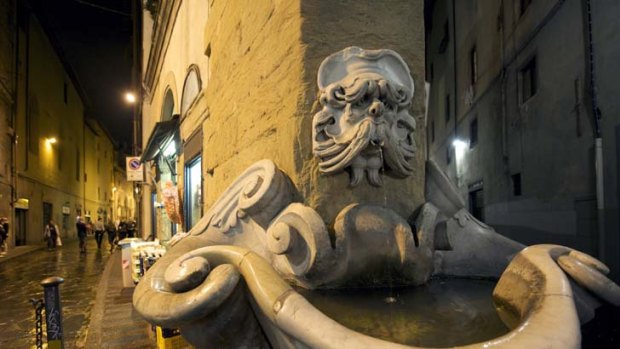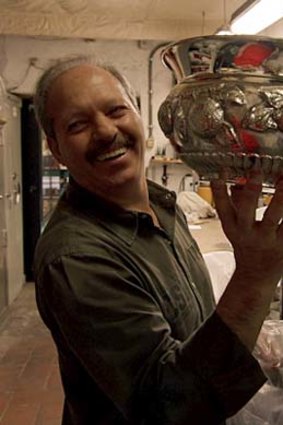
The city’s Oltrarno alleys.Credit: AFP
Shaney Hudson expores the artisan tradition found in a maze of workshops in a quiet part of Florence.
BEFORE Florence was famous for its artists, it was known for its artisans. For hundreds of years, Tuscan artisans have created leather, silver and clothing for the nobility in tiny workshops hidden up alleys in a little-visited part of Florence called the Oltrarno.
"When you are dealing with an artisan, it means you are buying something for you," says Luca Santiccioli, who leads today's Made in Florence: Oltrarno Artisans tour.

A silversmith displays an ornate creation.Credit: Shaney Hudson
"No two items are the same."
Roughly translated, Oltrarno means the other side of the Arno and refers to the quieter, working-class district over the Arno River from Florence's main tourist attractions.
Limited to six participants, our walk through the Oltrarno isn't a shopping tour but an exclusive look at dying Tuscan traditions in the private workshops and homes of the artisans themselves.
There are just four of us on the tour and Luca has arranged visits to three workshops. But as we head off, Luca points out that we're surrounded by artisans on every street. Through large open double doors on our left is a chandelier workshop and, to our right, wooden foot moulds hang from the ceiling of a shoe store.
Unlike most areas of central Florence, it's a neighbourhood still dominated by locals. We pass university students eating pizza in the sun on the steps of Santo Spirito church, a man in a wheelchair chatting with his elderly neighbour at the window of a fourth-floor apartment and a child riding his bike. Each time we pass a workshop, artisans wave and greet Luca by name.
Our first appointment is at a silver workshop run by Donato Zaccaro in a street that runs just off the area's main attraction, the Pitti Palace. In every sense, this tour is about going behind closed doors and we're led past the blue-velvet shelves of the shopfront to the organised chaos of the workshop.
Inside, wrapped parcels are stacked in the rafters while large safes sit against walls and chisels and stamping machines, moulds, other machinery and half-finished pieces crowd workbenches. Zaccaro's English is limited so he speaks in Italian over Luca's explanation, pulling us over to the safe to show us a thick plastic bag filled with pea-size balls of dull raw silver, which he will have pressed into small silver discs at the local foundry. The discs are then worked by hand into shapes and welded together like building blocks to create ornate silver pieces. Strapping himself to his workbench with a leather belt, Zaccaro demonstrates this process by using his body weight and tools he created himself to craft a small oil dispenser for a candelabra from three discs.
Luca explains that pieces are commissioned from around the world, mostly when commodity prices are low. Zaccaro shows us a recently finished commission, an ornate silver fruit bowl stamped with the serial number 573. Under Italian law, silversmiths are required to mark their goods, certifying their authenticity as Italian handicrafts. For me, the price is the best indication that it's real: the bowl costs about €2000 ($2730).
My favourite creation is the one that leaves me guessing. We're each handed a hollow, grape-size silver ball to palm and puzzle over. When we can't guess what it is, Luca reveals that once frozen it is an alternative to ice cubes, particularly for tipples such as whisky, because unlike melting ice it won't dilute the spirits. Zaccaro's ingenious new product is popular among high-end clients.
Our next stop is an etching house called L'Ippogrifo, where Gianni Raffaelli and his wife, Francesca, work together as engraver and printer. Etchings were the original way of printing the Bible and other books; today the process is mainly for invitations and prints.
In the back room, Luca tells us an etching is like a negative, losing clarity the more it is used. To ensure quality and exclusivity, the etched copperplate is cut after 150 prints. Francesca smears a small plate with black ink, rubbing the excess off with scraps from old telephone books. Paper is layered on top of the copperplate and with a few cranks she rolls the giant old press over it, gently peeling back the paper to reveal a perfect stamp of the image.
Our final destination is a workshop on the Piazza Santo Spirito, where metalworker Carlo Cecchi works with his partner, Giuliano Ricchi, to create cardholders, jewellery, pillboxes and knick-knacks. Cecchi's 50 years as an artisan are apparent in his hands; when he grasps mine in greeting, I am struck by how rough and thickened they feel.
Cecchi began work at the age of 15 but, as with the other workshops we visit, he has no apprentice. It's a sad reality but the tour offers a chance to see the last generation of Florentine artisans practising their trade. Tourist demand for space in Florence, coupled with new workplace-safety regulations, pushing artisans out of the Oltrarno area. Additionally, attracting a younger generation of apprentices is difficult; mastering a craft requires skill, practise, talent, years of experience and, as Luca sadly reflects, "there's no easy money".
To help counteract this, Context Travel, which is conducting the tour, founded a scholarship program to give young people the chance to study with Florentine artisans. Along with the tour, it's a small way of trying to preserve the artisanal traditions of one of the world's great cities.
And, in the bowels of Cecchi's workshop, we see there is still a strong demand for artisanal works. He passes me a metal strip stamped with the logos of his customers: Saks Fifth Avenue, Bloomingdales, even Christian Dior.
Luca explains that despite his high-profile international customers, Cecchi doesn't leave the workshop. "They have to come here to consult, he is too busy to travel."
Cecchi shows me a small Dior salt dispenser, cast in the mould of a seashell. A fish balances on its tail on the rim and it fits in the palm of my hand.
"French style," Cecchi grins, "but Italian handiwork."
The writer was a guest of Context Travel and Firenze Turismo.
Trip notes
Getting there
Qantas flies daily from Sydney to Rome (via London Heathrow) from $2200. 13 13 13, qantas.com. Fast trains connect Rome with Florence hourly and take about 90 minutes.
Staying there
Montebello Splendid has 60 rooms just across from the Oltrarno, from €330 ($452). +39 055 27 471, preferredboutique.com.
Touring there
Context Travel runs Made in Florence: Oltrarno Artisans tours weekly for €70 for three hours or €315 for a private tour. +39 06 976 25 204, contexttravel.com.
More information
Sign up for the Traveller Deals newsletter
Get exclusive travel deals delivered straight to your inbox. Sign up now.